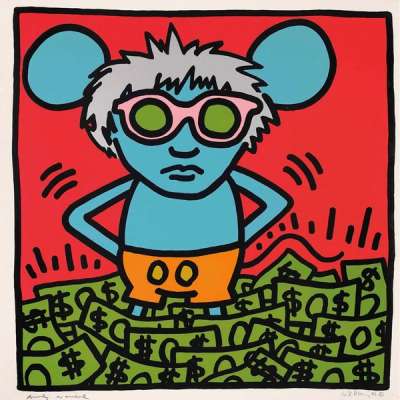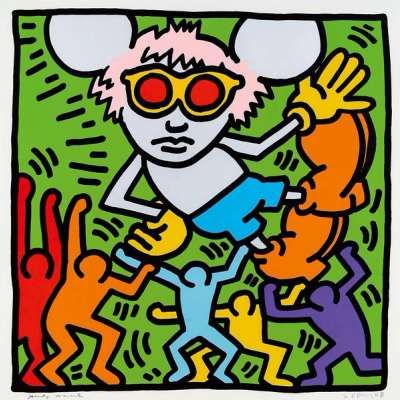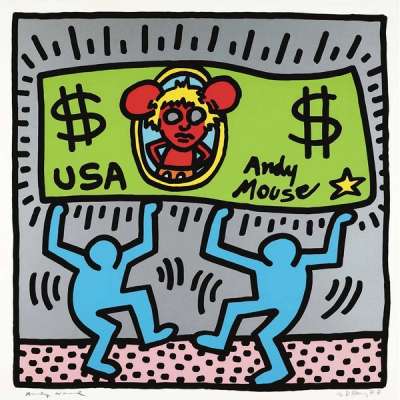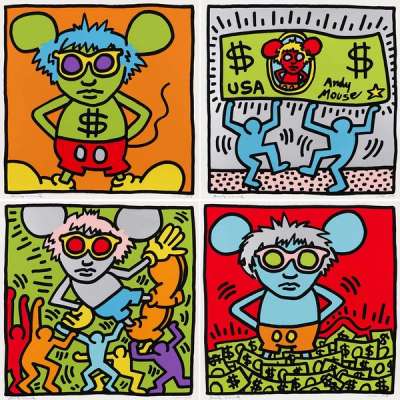
Andy Mouse 4

Andy Mouse 4
Signed Print
Keith Haring
£140,000-£210,000Value Indicator
$280,000-$420,000 Value Indicator
$250,000-$380,000 Value Indicator
¥1,290,000-¥1,930,000 Value Indicator
€170,000-€250,000 Value Indicator
$1,370,000-$2,060,000 Value Indicator
¥26,800,000-¥40,200,000 Value Indicator
$180,000-$260,000 Value Indicator
AAGR (5 years) This estimate blends recent public auction records with our own private sale data and network demand.
There aren't enough data points on this work for a comprehensive result. Please speak to a specialist by making an enquiry.
Medium: Screenprint
Edition size: 30
Year: 1986
Size: H 96cm x W 96cm
Signed: Yes
Format: Signed Print
TradingFloor
Track this artwork in realtime
Watch artwork, manage valuations, track your portfolio and return against your collection
Track auction value trend
Auction Results
| Auction Date | Auction House | Location | Hammer Price | Return to Seller | Buyer Paid |
|---|---|---|---|---|---|
| March 2023 | Christie's London | United Kingdom | |||
| September 2022 | SBI Art Auction | Japan | |||
| July 2020 | Ketterer Kunst Hamburg | Germany | |||
| February 2019 | Wright | United States | |||
| April 2016 | Christie's New York | United States | |||
| November 2010 | Germann Auctions | Switzerland |
Meaning & Analysis
Andy Mouse 4 is part of the Andy Mouse series released in an edition of 30 in 1986 in which Haring pays tribute to the father of Pop Art in Andy Warhol’s favoured medium, the screen print.
The final print in the Andy Mouse series features a perhaps disgruntled Warhol figure standing with his hands on his hips and wearing Mickey Mouse ears and shorts. His signature spiky wig and sunglasses help to identify this as the father of Pop Art, along with the bold colours of the screen print. The work can be read as a tribute to Warhol, whose influence on Haring was undeniable, and to the cartoons of Walt Disney which Haring began copying from a young age. It is perhaps these two factors that had the most impact on Haring as an artist and here they are joined in a celebratory image of energy and creativity.
The figure of Andy Mouse also features a dollar bill sign on his chest, representing both artists’ knowing relationship with commercialism. Not one to adhere to the distinctions between the so-called ‘high’ and ‘low’ art, Haring believed that art should be for the masses rather than the elite few. To this end he began his career by working in the street, painting murals for the enjoyment of passersby. Even as he achieved some critical and commercial success, Haring continued to make his art available to the everyman by opening a series of Pop Shops in which kids and collectors alike could shop for his signature works on badges, t-shirts and figurines for as little as 50 cents. This drive towards mass consumption was in part due to Warhol’s pioneering work in the 60s where he elevated screen printing from a commercial process to a fine art.
Haring began screen printing in 1983 after some initial experiments with lithography and began to work with publishers across the US and Europe, producing ever more inventive and daring work. Printed in an edition of 30, each sheet from the Andy Mouse series demonstrates an element of precision that shows the level of care with which he supervised the process.
Keith Haring was a luminary of the 1980s downtown New York scene. His distinctive visual language pioneered one-line Pop Art drawings and he has been famed for his colourful, playful imagery. Haring's iconic energetic motifs and figures were dedicated to influencing social change, and particularly challenging stigma around the AIDS epidemic. Haring also pushed for the accessibility of art by opening Pop Shops in New York and Japan, selling a range of ephemera starting from as little as 50 cents. Haring's legacy has been cemented in the art-activism scene and is a testament to power of art to inspire social change



